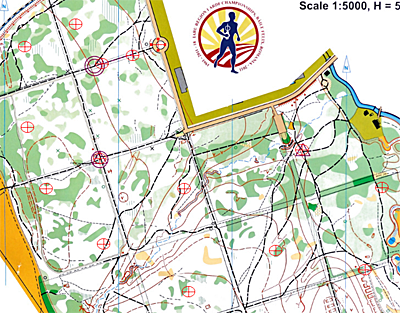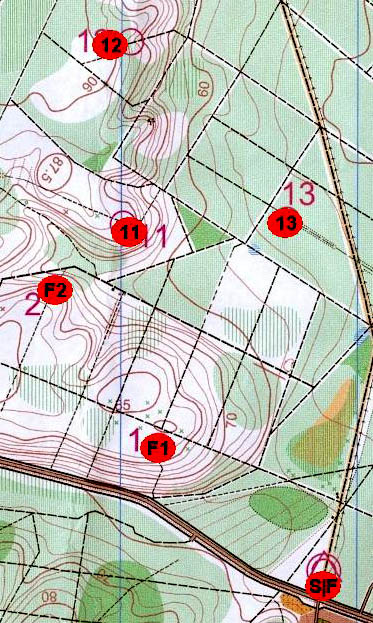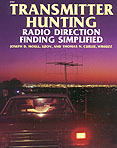Sprints
 Sprints are intended to bring ARDF nearer to the public and to attract potential sponsors and new athletes to ARDF. They should take place in forests or city parks that are easily accessible by the public on either Day 1 or the free day between the main competitions. Only 80 meters is used for sprints. The competition course has two loops with a spectator run through the finish area between them.
Sprints are intended to bring ARDF nearer to the public and to attract potential sponsors and new athletes to ARDF. They should take place in forests or city parks that are easily accessible by the public on either Day 1 or the free day between the main competitions. Only 80 meters is used for sprints. The competition course has two loops with a spectator run through the finish area between them.
The first sprint loop has five slow-keyed transmitters on one frequency. The second loop has five fast-keyed transmitters on another frequency. There is a spectator beacon on a third frequency and a finish beacon on a fourth frequency. The four frequencies are at least 30 KHz apart.
Each sprint competitor runs through the start corridor, which leads to the area with slow keyed transmitters 1 through 5. After finding all the required transmitters from this loop in any order, he/she runs to the spectator control and then through the spectator corridor to the area with fast keyed transmitters 1F through 5F. After finding all the required transmitters from this second loop in any order, the competitor runs to the finish beacon and through the finishing corridor to the finish line.
A portion of the sprint map from the 2011 Region 1 ARDF Championships in Romania is shown at right with the fox locations added in. The start triangle is at center-right. Competitors found their required of the first five foxes, then navigated to the spector control, marked as a start-finish circle-triangle at center-left. From there they went through a spectator corridor out to find their required of the second five foxes, then on to the finish, marked as concentric circles at upper-left.
Here are additional differences between the sprint and the main 80m event:
- Sprint courses are planned for an expected winning time of 15 minutes in all categories.
- The map for a sprint event is scaled 1:5000 or 1:4000.
- Each sprint competitor receives the map along with his/her receiver in the pre-start area 2 minutes before the start.
- Sprint competitors start at two-minute intervals.
- Sprint transmitters have lower output power (0.3 to 1.0 watt).
- Both sets of sprint transmitters are on for 12 seconds each in numbered sequence for a one-minute total cycle.
- Sprint transmitters have registering devices (such as e-punch) but no flags.
- Sprint competitors must find the same number of slow-keyed transmitters and fast-keyed transmitters as for his/her category in the main competitions. For instance, if M60 competitors are required to find 3 foxes in the main competition, then they must find three slow-keyed and three fast-keyed sprint transmitters.
- Sprint transmitters are at least 100 meters apart and are at least 100 meters from the start.
At the start, foxoring competitors get a map marked with nominal positions of at least ten transmitters, plus the start and finish beacon locations. The fox transmitters are close to their nominal positions as marked on the maps. Part of the foxoring map from the 2011 Netherlands ARDF Championships is shown at right.
All foxoring transmitters operate continuously. They are very weak and therefore are audible only in the near vicinity of the antenna. Competitors navigate close to transmitters by means of the map and then complete the final approach by RDF. The finish beacon operates at normal power (1W to 5W).
As in regular ARDF, the designated transmitter numbers to be found by competitors in each category are announced in advance.
Additional rules for foxoring:
Go to International-Style Foxhunting Comes To The Americas -- An introduction to the sport with the history of its development in the Western Hemisphere
Go to Radio-Orienteering in southern California -- Announcements of upcoming demonstration/practice sessions and results of recent local events
Go to Equipment Ideas for Radio-Orienteering -- Simple and inexpensive receiving and transmitting solutions
Go to A Video that Explains and Promotes ARDF -- Show it to your local ham radio and orienteering clubs
Go to Electronic Scoring for ARDF -- What it is, how it works, and why it's better than pin punching
Go to Try ARDF on 80 Meters -- The "other" foxhunting band
This page updated 1 May 2013
Foxoring
 Foxoring seems like an ideal way to get classic orienteers interested in ARDF. It encourages ARDF enthusiasts to improve their orienteering skills. Only 80 meters is used for foxoring.
Foxoring seems like an ideal way to get classic orienteers interested in ARDF. It encourages ARDF enthusiasts to improve their orienteering skills. Only 80 meters is used for foxoring.
Category Number of Foxes Course Length
(as announced)
W19 5 to 8 4 to 6 Km
W21 6 to 10 5 to 7 Km
W35 5 to 8 4 to 6 Km
W50 4 to 7 3 to 5 Km
W60 4 to 7 3 to 5 Km
M19 6 to 8 6 to 8 Km
M21 8 to 10 7 to 9 Km
M40 6 to 8 6 to 8 Km
M50 5 to 8 5 to 7 Km
M60 5 to 8 4 to 6 Km
M70 4 to 7 3 to 5 Km
 Go to Latest Championship Foxhunting News -- Stories of recent multi-nation ARDF events and announcements of upcoming ones
Go to Latest Championship Foxhunting News -- Stories of recent multi-nation ARDF events and announcements of upcoming ones Back to the Homing In home page
Back to the Homing In home page